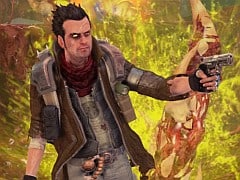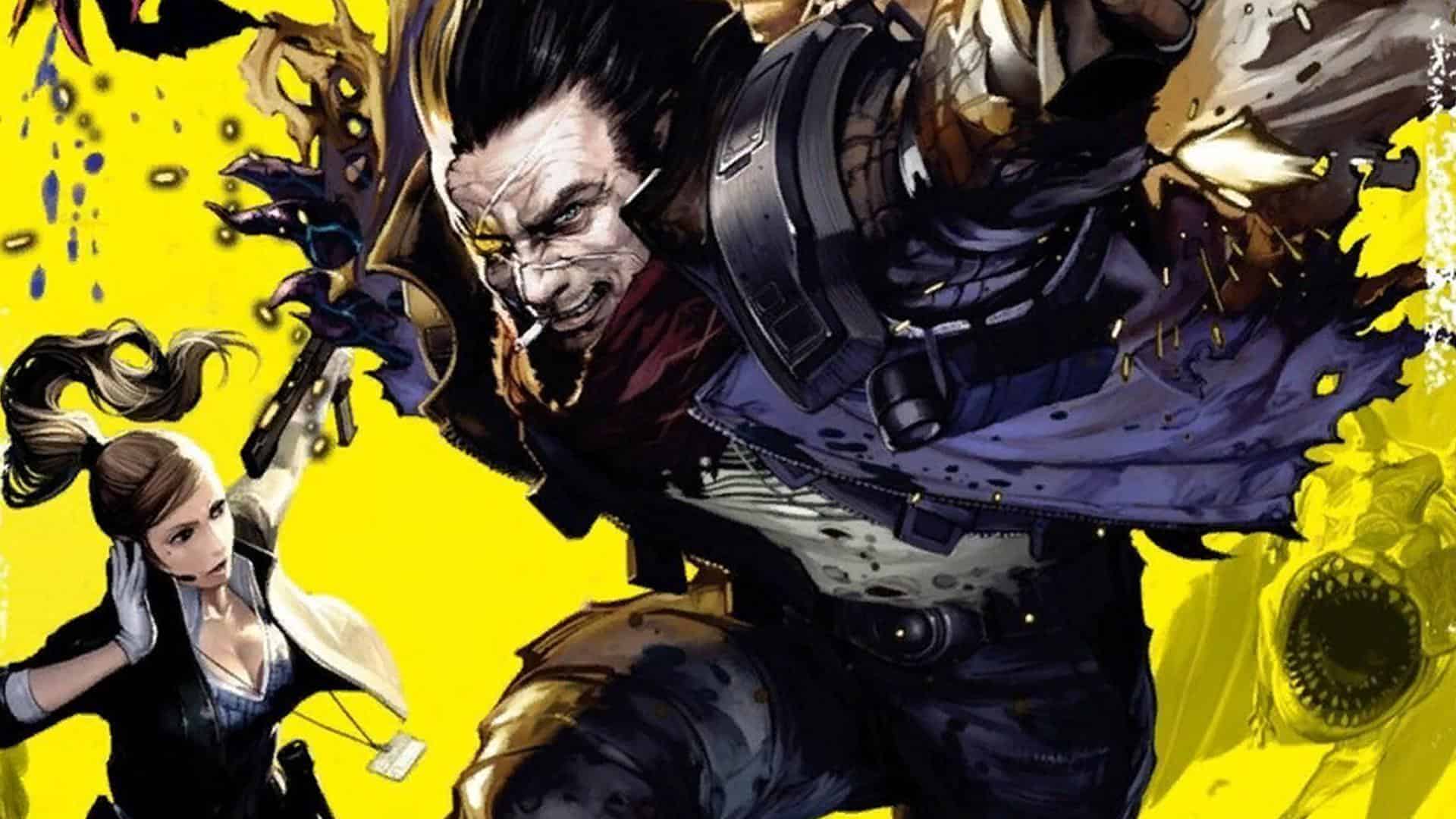You can trust VideoGamer. Our team of gaming experts spend hours testing and reviewing the latest games, to ensure you're reading the most comprehensive guide possible. Rest assured, all imagery and advice is unique and original. Check out how we test and review games here
You can tell a lot about a game by the stuff it asks you to pick up. Take Uncharted, for example, which squirrels away unique archaeological treasures off the beaten track, a conceit entirely in keeping with the series’ fiction. Super Mario 3D Land’s medals tease you into tricky tests of platforming skill or inquisitive probing. Batman: Arkham City, meanwhile, has the Riddler trophies, each an entertaining environmental puzzle to solve. In NeverDead, collectibles hide in plain sight, happily giving off a bright yellow glow. In NeverDead, collectibles are called ‘collectibles’.
Collectable ‘collectibles’ just about sums up the lack of inspiration in NeverDead, and that’s doubly disappointing given a genuinely decent idea at its core. 500-year-old demon hunter Bryce Boltzman is immortal, you see, which means he responds rather differently to serious injury than you or I.
Throughout eight hours of shooting and slicing, Bryce will frequently be dismembered, and can recover by hopping, rolling or crawling into the limbs he’s lost. It’s a fun novelty at first, though the concept of a human katamari never really goes any further than that. You’ll flap about on the floor as a head with a single arm attached, dragging yourself awkwardly back to your torso, but beyond fleeting amusement there’s nothing particularly interesting about it as a mechanic.
After the first level, Bryce gains the ability to remove his own head. In another game – in a better game – this self-mutilation might be used for some clever puzzles. Here you’ll throw Bryce’s head to pass through vents (complete with a ridiculous sound effect that suggests somebody enthusiastically rolling marbles down a metal pipe) or reach higher platforms, and that’s pretty much your lot. There’s one puzzle involving a plank of wood you need to accelerate up to jump off that is both remarkably fiddly yet, astonishingly, one of the most inventive conundrums in the entire game. The very best puzzle involves pulling levers to rotate sections of pipe into position, only – you’ll never guess – one of the levers simultaneously moves several pieces. Ah, Rebellion, with these brainteasers you are really spoiling us.
Shortly afterwards, Bryce suddenly remembers he’s capable of tearing his own arms off, too. This is only used during combat, and you’re encouraged to do so because puppies – the game’s basic enemies – apparently “love to play fetch”. The advantages to this are no-fold. Rip one arm off and you’re instantly one gun down. You can still fire from your now-missing limb, but at this point it’s probably flailing around on the floor, haphazardly scattering bullets when you could be putting it to better use by, say, shooting an enemy directly in the face. Besides, combat is so frenetic that you’ll perhaps only distract one or two puppies (if you’re lucky) while the rest leap at you to rip your other arm off because you’ve inexplicably reduced your firepower by half. Sure, you can purchase an ability that turns your limbs into grenades, which makes this ability marginally less pointless, but why bother when firing both guns is the easiest way to send these demons to their maker?
Enemies take quite a bit of punishment before disintegrating, and there’s little sense of weight or force to almost every weapon. Often, the only evidence you’re doing damage to your intended target is the gradually depleting life bar above its head. The puppies, waddling, leaping, eating machines that they are, come in a few varieties (armoured, fiery, explosive) but their M.O. is identical: hurl self at demon hunter. The same goes for their bizarre triped colleagues, with some sporting giant razors on their uppermost tendril and others packing attached machine guns. Curiously, these are immune to gunfire, forcing you to pull out Bryce’s butterfly blade, which uses the right stick for multi-directional attacks. You’re told that precise swipes are the most efficient tactic, presumably because Rebellion doesn’t want to admit that frantically waggling the stick back and forth is actually the best strategy.
A couple of additional demon types are introduced in the second half of the game, but do little to alleviate the repetition. There are two basic types of encounter: rooms containing ‘wombs’ which endlessly spit out enemies until you destroy them, and areas blocked off by demon seals, which trap you until you’ve killed everything in sight.
Bosses are a welcome change of pace, but with one exception they’re all defeated in the same way: expose weak point, attack weak point. On occasion you don’t even need to bother with the first. Mind you, perhaps keeping it simple is wise; whenever Rebellion attempts anything more ambitious, the game falls apart as easily as its protagonist. One fight, set inside a boss’s rotating stomach, sees the otherwise acceptable camera completely lose the plot. Admittedly, it does do a neat line in destructible scenery – at least, it would be neat if it didn’t have such an impact on framerate. Killing enemies with crumbling masonry can shorten battles considerably, but environments are so busy and combat so chaotic that you’re more likely to squash something by happy accident rather than intelligent design.
Your partner, Arcadia, will occasionally need reviving, but you have plenty of time to save her and she mostly stays out of trouble – even if she’s no real help in a fight. Which means the only real danger comes from the skittish vacuum monsters that swallow Bryce’s head when it’s separated from his body. When this happens – and it will, because they’re faster than you – you need to press a button at the right time to force them to spit you out. Fail to time it properly and it’s back to the last checkpoint. This isn’t too frustrating as checkpoints are sensibly spaced, but it becomes an issue thanks to dismemberment being governed by an unfathomable system. There’s no consistency whatsoever – a direct hit from an enemy can leave you without a scratch, then the next will scatter your limbs across the room.
The script, meanwhile, is woeful. Bryce is supposed to be a wisecracking anti-hero, but that would suggest there’s an element of wit to his dialogue. Presenting him with a mere handful of whiny soundbites to grunt whenever decapitated is a wretched idea, making him less likeable the more often he’s beheaded. His backstory – told through some nicely-rendered CGI cutscenes – is the most interesting element of the plot, but it jars against the attempted jokiness of the present-day scenario. “C’mon – we don’t have time for these childish games,” tuts Arcadia, just as her cleavage fills the screen. Well, you said it. That the soundtrack, comprising almost exclusively of juddering metal from Megadeth, often drowns out the dialogue is actually a small mercy.
NeverDead isn’t entirely without good ideas. The upgrade system is nicely implemented, allowing you to switch abilities at any time, as long as you have the slots to accommodate the abilities you want. It’s a particular boon when you’re fighting a boss and need to adopt a different approach from the standard scraps. And there’s one brief moment of levity during a rare bit of downtime at Arcadia’s apartment, where a series of throwaway interactions allow Bryce to give his head a rinse in the washing machine, or clean his teeth for the first time in 126 years.
But the most surprising thing about NeverDead is just how boring it all is. This is an utterly generic shooter with an inspired dismemberment mechanic that neither Rebellion nor director Shinta Nojiri seems to know what to do with. Lacking any kind of spark whatsoever, it becomes increasingly apparent that NeverAlive would be a more honest title.
Version Tested: PlayStation 3

/https://oimg.videogamer.com/images/1386/neverdead_119.jpg)






